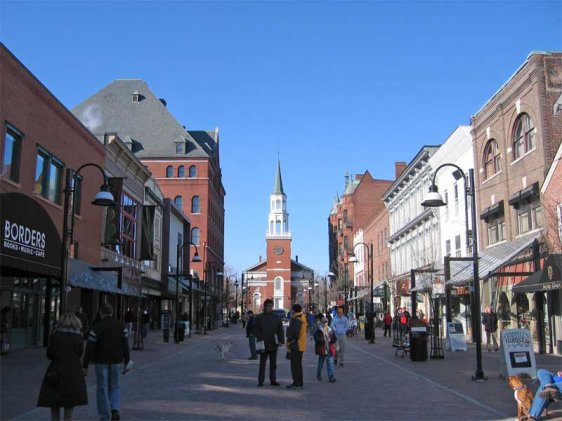Burlington is the largest city in Vermont. It is located in Chittenden County, on the northwestern part of the state. Burlington covers 15.5 sq mi (40.1 sq km) and has a population of 106,000 people (2011 estimate), within a metropolitan area of 208,000 people.
 Burlington, Vermont
Burlington, VermontSource: https://commons.wikimedia.org/wiki/File:BurlingtonVT_ChurchStreet.jpg
Author: Jared C. Benedict

Burlington is on the eastern shore of Lake Champlain, which forms the border between Vermont and New York State. It experiences a humid continental climate with warm, humid summers and cold winters. July is the warmest month, when the average high temperature touches 81°F. In January, the average low temperature may drop to 9°F. The summer months are also the wettest, with July and August each receiving 4 in of rain.
The founding of Burlington goes back to the 18th century, when Governor Benning Wentworth instituted land grants. The land in the Burlington area went to Samuel Willis and 63 others in 1763. After a period of land clearing, the town was established in 1785. It was chartered as a city in 1865.
By the 19th century, Burlington began to take advantage of its location on Lake Champlain as a trading port. The completion of the Champlain Canal in 1823 and the Erie Canal in 1825 further helped to increase trade through the town.
Today Burlington is a livable town with a good standard of living and a relaxing feel, ideal as a place for older residents.
Visiting Burlington
Burlington International Airport (BTV) receives flights from Atlanta (from June 2012), Chicago, Detroit, New York-JFK, Philadelphia and Washington DC. The city is served by Interstate 89 (Exit 14).Places of Interest in Burlington
- Shelburne Museum
Museum with a varied collection ranging from American paintings to exhibits of carriages, costumes and decorative arts.
 Latest updates on Penang Travel Tips
Latest updates on Penang Travel Tips

Copyright © 2003-2025 Timothy Tye. All Rights Reserved.

 Go Back
Go Back